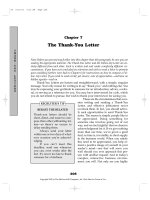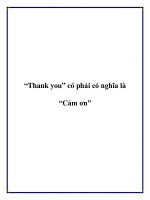4 6 4 thank you, sir isaac newton (expository nonfiction)
Bạn đang xem bản rút gọn của tài liệu. Xem và tải ngay bản đầy đủ của tài liệu tại đây (2.59 MB, 8 trang )
Reader
Thank You,
Sir Isaac Newton!
Genre
Expository
Nonfiction
Build Background
• Scientific
Discovery
• Force and
Motion
• Roller Coasters
Access Content
• Labels and
Captions
• Definitions
• Fact Boxes
• Diagram
Extend Language
• Related Words
Scott Foresman Reading Street 4.6.4
ì<(sk$m)=becbfg< +^-Ä-U-Ä-U
ISBN 0-328-14215-8
by Aaron Showley
Illustrated by Donna Catanese
Talk About It
Thank You,
Sir Isaac Newton!
1. Look at the diagram on page 4. Explain Newton’s
first law of motion in your own words.
2. Give an example of a force that can stop a
moving object.
Write About It
by Aaron
Showley
3. On a separate paper,
write
a definition, draw a
picture, or give an example of the following key
words from the book.
Word
Definition, Illustration, or Example
motion
gravity
force
friction
momentum
Extend Language
The word motion means “movement.” The words or
phrases motionless, locomotion, and motion picture
are related to the word motion. Use a dictionary to
find out what each word or phrase means.
Photographs
Cover ©Richard Cummins/Corbis; 1 ©Godfrey Kneller/Art Resource, NY; 3 ©Godfrey
Kneller/Art Resource, NY; 8 ©Richard Cummins/Corbis; 11 ©The Image Bank/Getty
Images; 12 ©Bettmann/Corbis.
ISBN: 0-328-14215-8
Illustrated by Donna Catanese
Copyright © Pearson Education, Inc.
All Rights Reserved. Printed in the United States of America.
This publication is protected by Copyright, and permission should be obtained from
the publisher prior to any prohibited reproduction, storage in a retrieval system,
or transmission in any form by any means, electronic, mechanical, photocopying,
recording, or likewise. For information regarding permission(s), write to: Permissions
Department, Scott Foresman, 1900 East Lake Avenue, Glenview, Illinois 60025.
Editorial Offices: Glenview, Illinois • Parsippany, New Jersey • New York, New York
Sales
Massachusetts
• Duluth,
1234
5 6 7Offices:
8 9 10 Needham,
V0G1 09 08
07 06 05 04 03
02 01 00Georgia • Glenview, Illinois
Coppell, Texas • Sacramento, California • Mesa, Arizona
Has this ever happened to you? You are in the
car with your mom. You are drinking a cup of
water. Everything is fine. But then another driver
pulls right in front of your car. Your mom has to
step on the brakes to avoid hitting the other car.
Suddenly, your water is all over the floor, and
you are wet! Your cup of water spilled. But you
did not tip the cup, or drop it. What happened?
2
Here’s another
problem. You are late
for school. You are
in a hurry. You put
your books on the
roof of the car, open
the door, get in, and
close the door. Mom
starts the car and
drives off. Yikes! You
forgot to get your
books off the roof of
Sir Isaac Newton
the car. The books fall
down to the ground
where the car was parked. Why?
These things can be explained by a law of
science called Newton’s first law of motion. Sir
Isaac Newton was a great scientist. He lived
about 300 years ago in England. Sir Isaac Newton
asked many questions about the world around
him. He made observations about the world, and
he did experiments. His work led him to discover
the laws of motion.
brakes: devices that slow or stop something
motion: movement
avoid: prevent
made observations: carefully looked at and thought
3
Did You Know?
Laws of Science
• Laws of science are different from other laws. In
everyday life, a law is a rule to follow. If you break
a law, you get into trouble.
• A law of science is a law that everything in the
universe follows. You can’t break a law of science.
Take the law of gravity, for example. If you drop
a book, it falls to the floor. It doesn’t fly up to the
ceiling. Gravity pulls it down, toward Earth, toward
the ground. That is a law of science.
In this book, you’ll learn about Newton’s
first law of motion. Newton’s first law says this:
Objects continue doing what they are doing
unless another force acts on them. An object
at rest (not moving) stays at rest unless a force
moves it. A moving object keeps moving unless a
force stops it.
Newton’s First Law of Motion
Object is at rest
Object stays at rest
Object is moving
Object keeps moving
break a law: disobey a rule
But a moving
object can stop
leash
moving, and an
object at rest
can be moved.
You can stop a
moving object by
pulling on it. For
example, have you
ever pulled a dog’s
leash? If you pull with enough strength to
overcome a dog’s movement, the dog will stop!
When you push or pull, you are applying, or
using, a force.
An object at rest will stay at rest until a force
pushes it or pulls it. You can push it or pull it, and
the object will
move—unless it
is too heavy! A
thing may move
if you kick it.
But do not kick
something that
is too heavy.
Your foot might
suddenly stop!
ball
gravity: a force that pulls an object toward something
else; a force that pulls things toward Earth
force: power or energy
4
5
Let’s look at what happened
path
to the water in the car. The
water in your cup was moving.
It did not look like it was
moving because it was moving
along with the car. If the car
was traveling forward at 30
miles per hour, the water was
traveling forward at 30 miles
per hour too.
When your mom stepped on the brake pedal,
the car slowed down or stopped. The car’s brakes
made the car stop. Your water did not have
brakes, so it kept going—right onto the floor.
Remember, a moving object keeps moving until a
force stops it. That is the law!
Why did the brakes stop the car? Brakes work
because of friction between parts of the brakes
and the wheels, and between the tires and the
road. The friction was stronger than the car’s
movement forward, so the car stopped. But there
was no friction to stop the water so quickly, so it
kept moving.
Let’s take
another look
at Newton’s
first law. You
are riding a
bicycle on
a flat road.
It is easy to
ride the bike.
You turn a corner, and the wind is in your face.
Suddenly, it is harder to pedal. What happened?
You are still pedaling just as hard, but the force
of the wind is pushing against you. The wind is
strong, so your bike slows down.
Did You Know?
Friction
• Bike riders understand friction. It is harder to
go fast on a rough path than on a smooth one
because a rough path causes more friction. Friction
slows movement.
• A bike’s brakes work because of friction too.
When you press your brakes, parts of the brakes
press against a moving wheel. The bike slows
down or stops.
friction: the rubbing of one object against another
6
7
roller coaster
The Giant Dipper in Santa Cruz,
California, was built in 1924, but
people still love it today.
We have discussed Newton’s first law of
motion. Sir Isaac Newton was a thinker and a
dreamer. Many other people are dreamers too.
People love to use their imaginations. A scientist
makes a discovery, and then people think, “How
can we use this discovery? What new thing can
we make?”
People have used Sir Isaac Newton’s ideas
to make their dreams come true. One man who
did that was LaMarcus Thompson.
In the 1880s, LaMarcus Thompson used his
knowledge of Newton’s laws of motion to build
a roller coaster! Thompson’s ride was built in
1884 at Coney Island, New York. The age of roller
coasters had begun! People ride in a train of
small cars that roll, or move, up and down on a
roller coaster’s tracks—just for fun.
Here is how an old-fashioned, wooden roller
coaster works.
A motor and chain start the train by pulling it
to the top of a tall hill. After that, the train is on
its own. There is no engine in the train. There is
no electricity running through the tracks.
Earth’s gravity pulls the train down the hill. The
train is heavy, so it goes fast. For example, riders
on the Giant Dipper drop from a height of 70 feet.
The train goes 55 miles per hour down the hill.
As the train speeds down the hill, Newton’s
first law of motion takes over. Remember: A
moving object keeps moving unless another
force acts on it. The train is moving, so it keeps
on moving. The train uses its momentum to go
up, down, and around the track.
is on its own: has nothing to help it
8
9
rail
During most of the ride, friction and wind are
not strong enough to slow the train. A heavy,
fast-moving train has much momentum. But near
the end of the ride, the train has to slow and stop.
Inventors of roller coasters use the laws of
motion to slow and stop the trains too. Some
roller coasters have a long, straight, flat track
near the end of the ride. On this flat track, the
train loses some momentum. Then, the train
goes up a small hill. Gravity pulls on the train as
the train goes up. This slows the train too. Next,
bumpers on the track create friction. Finally, the
wheels push up against a barrier. The train stops.
Did You Know?
In some steel
roller coasters,
riders sit on
seats hanging
from a rail
above them.
Their legs
hang free as
they would
in a glider.
Momentum
A moving object moves with force, or momentum.
The amount of momentum depends on two things:
• how fast the object is moving
• how heavy the object is
barrier: thing that blocks the way or stops movement
10
Today’s roller coasters are smoother and faster
than early roller coasters. Many of them glide
along on smooth, steel tracks. The new, smooth
tracks reduce friction, or drag, on the train so
the train can go very fast! La Marcus Thompson’s
tracks were built out of wood, but both kinds of
roller coasters use force, momentum, and friction
to work.
steel: strong metal
11
Talk About It
1. Look at the diagram on page 4. Explain Newton’s
first law of motion in your own words.
2. Give an example of a force that can stop a
moving object.
Write About It
3. On a separate paper, write a definition, draw a
picture, or give an example of the following key
words from the book.
Word
Definition, Illustration, or Example
motion
gravity
force
friction
momentum
Extend Language
Sir Isaac Newton
The laws of motion have always worked.
Sir Isaac Newton did not invent them. But he did
explain how they work.
Thanks to Sir Isaac Newton, we understand
the laws of motion. You use them when you ride
your bike or kick a ball. Inventors use them to
dream up new inventions, including new rides
for amusement parks! Maybe you will invent a
ride one day. What kind of ride would you like
The word motion means “movement.” The words or
phrases motionless, locomotion, and motion picture
are related to the word motion. Use a dictionary to
find out what each word or phrase means.
Photographs
Cover ©Richard Cummins/Corbis; 1 ©Godfrey Kneller/Art Resource, NY; 3 ©Godfrey
Kneller/Art Resource, NY; 8 ©Richard Cummins/Corbis; 11 ©The Image Bank/Getty
Images; 12 ©Bettmann/Corbis.
ISBN: 0-328-14215-8
Copyright © Pearson Education, Inc.
All Rights Reserved. Printed in the United States of America.
This publication is protected by Copyright, and permission should be obtained from
the publisher prior to any prohibited reproduction, storage in a retrieval system,
or transmission in any form by any means, electronic, mechanical, photocopying,
recording, or likewise. For information regarding permission(s), write to: Permissions
Department, Scott Foresman, 1900 East Lake Avenue, Glenview, Illinois 60025.
1 2 3 4 5 6 7 8 9 10 V0G1 09 08 07 06 05 04 03 02 01 00
12









